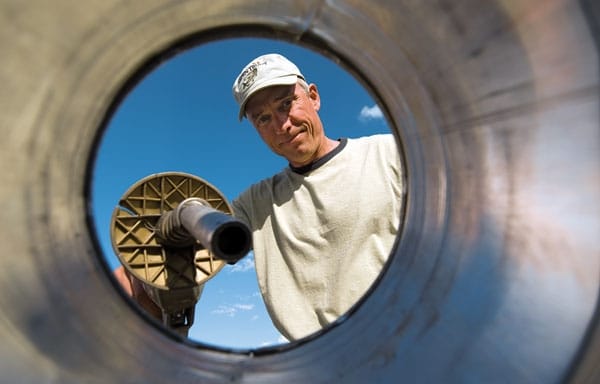
100-0610tanks_main
A whiff of gas in the bow compartment of my skiff was the first hint of trouble. But a check of the hoses, clamps and filter revealed no cracks or leaks. Later, after dropping a nut into the forward bilge sump, I stuck my fingers into a puddle of raw gas. My worst fears were confirmed. The 58-gallon tank in my nine-year-old Bayshore was leaking and would have to be replaced before I could safely use the boat again. A growing segment of boaters find themselves in similar predicaments every season.
Whether due to cracks, corrosion, installation issues or ethanol, leaking and deterio-rating fuel tanks are a common problem with older boats.
“The Coast Guard has done studies that show aluminum tanks last about 12 years on the average,” says John Gallo, president of Atlantic Coastal Welding in Bayville, New Jersey. “But if a tank is installed correctly, it can last indefinitely. We’ve been coating the outside of all our aluminum tanks with epoxy since 1978 and have had good results doing that. It gives the tank extra protection against corrosion and prolongs the life.”

The U.S. Coast Guard is the agency that establishes marine fuel-tank regulations. Construction materials and thickness, grounding, venting, pressure checks, load distribution and insulation are among the many stipulations in part 183 of the Code of Federal Regulations. Boat builders adhere to additional safety and design standards established by the American Boat and Yacht Council and the National Marine Manufacturers Association. Most marine tanks are built from aluminum. Stainless steel has limited applications because of the metal’s hardness and cost. Permanent polyurethane or plastic replacement tanks are additional options for both gas and diesel applications.
Fiberglass fuel tanks, common in older sport-fishing models, are becoming increasingly problematic because of ethanol-enhanced gasoline. The solvent properties of ethanol break down the resin in the fiberglass. The sloughed-off sludge then clogs fuel injectors and overloads filters. Replacing the fiberglass tank is the only viable solution.
Besides the cost of a replacement, there’s tank installation, which can be labor-intensive. Boats with accessible compartments, like those with a deck seam around the console, are obviously easier to work on. On boats without easy access, the deck usually has to be cut to remove the tank. Afterward, the deck has to be reglassed. If internal flotation foam in the hull is soaked with leaked gas, it has to be removed with hand tools since power tools might give off a spark. No matter how you look at it, replacing a tank is not a cheap proposition.

There are benefits to tank replacement, though, besides defusing a potential floating bomb. Along with prolonging the life of an otherwise serviceable craft by years, many owners increase their boat’s range with a larger tank capacity. A lot depends on the hull and stringer setup, but if the tank has to be replaced anyway, it’s an option to consider, for relatively little added cost.
Although they don’t install the tanks they build, companies like Atlantic Coastal Welding do have dozens of different tank templates to fit most applications, including rectangular, belly and saddle designs. Most also offer custom builds, along with detailed installation instructions for owners who decide to take on the project themselves. If you do replace a tank yourself, pay special attention to those instructions. Failure to do so could result in a safety hazard at the worst or a shortened tank life at the least.
With the recent advancements in manufacturing processes, rotationally molded polyurethane tanks are yet another option for replacing bad aluminum or fiberglass gas or diesel tanks. Moeller Marine Products is the chief supplier of poly tanks for both original builders and aftermarket replacement.

“Our tanks have several advantages over metal tanks,” says Earnie Cook, Moeller’s director of product development and technology. “They are corrosion-resistant, extremely durable and a great value for the money.”
Moeller builds standard gas tanks up to 350 gallons and diesel tanks up to 700 gallons. Depending on a tank’s capacity and requirements, added features like internal fuel pumps, reinforcing ribs, and baffles or cones to minimize sloshing are available.
Cook says Moeller can also build custom tanks to add more fuel capacity or fit unusual mounting requirements. The flexibility of computer-aided design and the quick retooling possible through the roto-mold process allow the company to build special tanks efficiently. Moeller tanks are available through regional marine distributors or web-direct through Ocean Link Inc.
My skiff is once again ready for action now that I have a new metal tank installed. Winchell Marine, the custom shop that did the work, made several modifications to drain and ventilate the compartment so salt water and moisture won’t collect and corrode the new tank like they did the original. My wallet is lighter, but at least now I won’t have to worry about my gas tank for a long, long time.









